2019 CHRYSLER 300 heater
[x] Cancel search: heaterPage 227 of 492
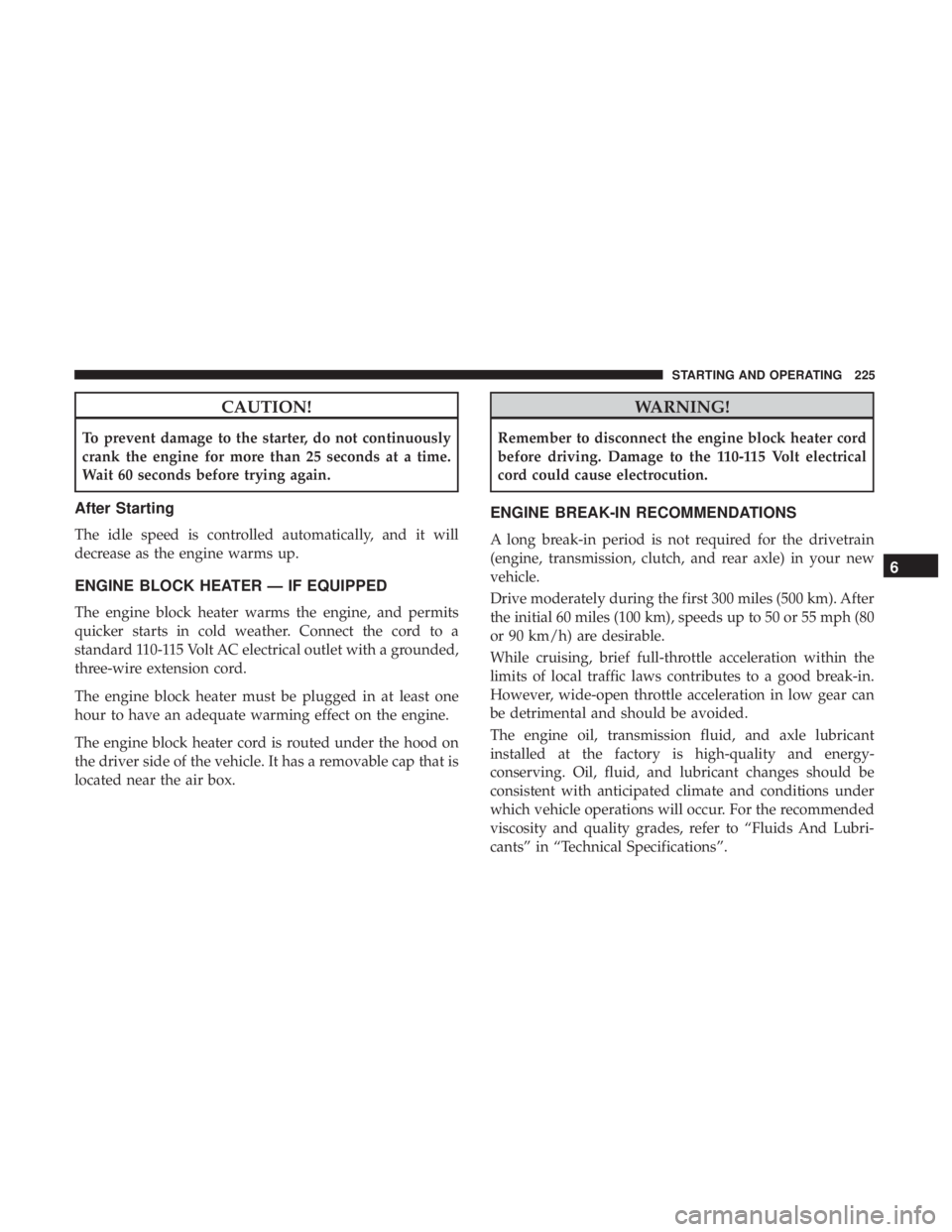
CAUTION!
To prevent damage to the starter, do not continuously
crank the engine for more than 25 seconds at a time.
Wait 60 seconds before trying again.
After Starting
The idle speed is controlled automatically, and it will
decrease as the engine warms up.
ENGINE BLOCK HEATER — IF EQUIPPED
The engine block heater warms the engine, and permits
quicker starts in cold weather. Connect the cord to a
standard 110-115 Volt AC electrical outlet with a grounded,
three-wire extension cord.
The engine block heater must be plugged in at least one
hour to have an adequate warming effect on the engine.
The engine block heater cord is routed under the hood on
the driver side of the vehicle. It has a removable cap that is
located near the air box.
WARNING!
Remember to disconnect the engine block heater cord
before driving. Damage to the 110-115 Volt electrical
cord could cause electrocution.
ENGINE BREAK-IN RECOMMENDATIONS
A long break-in period is not required for the drivetrain
(engine, transmission, clutch, and rear axle) in your new
vehicle.
Drive moderately during the first 300 miles (500 km). After
the initial 60 miles (100 km), speeds up to 50 or 55 mph (80
or 90 km/h) are desirable.
While cruising, brief full-throttle acceleration within the
limits of local traffic laws contributes to a good break-in.
However, wide-open throttle acceleration in low gear can
be detrimental and should be avoided.
The engine oil, transmission fluid, and axle lubricant
installed at the factory is high-quality and energy-
conserving. Oil, fluid, and lubricant changes should be
consistent with anticipated climate and conditions under
which vehicle operations will occur. For the recommended
viscosity and quality grades, refer to “Fluids And Lubri-
cants” in “Technical Specifications”.
6
STARTING AND OPERATING 225
Page 332 of 492
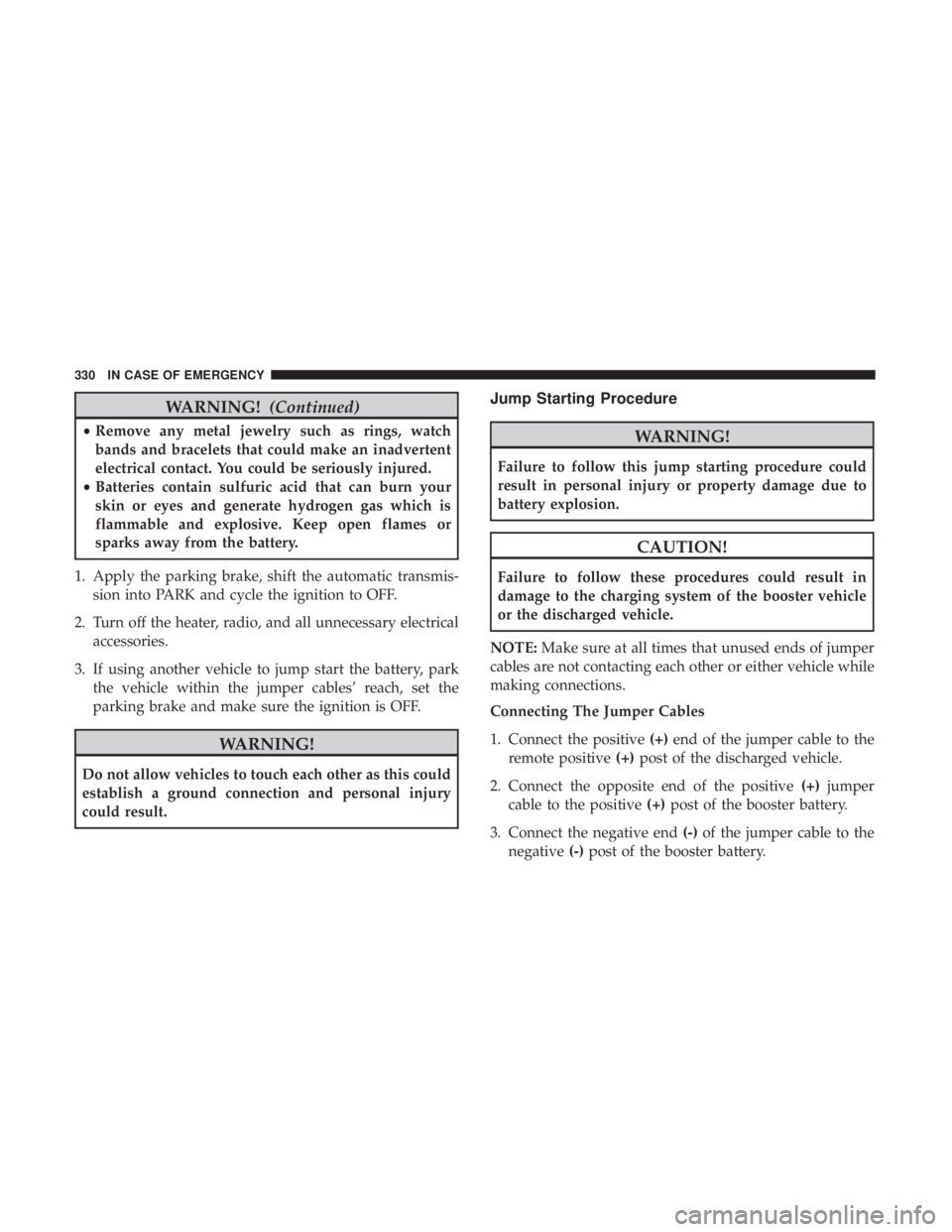
WARNING!(Continued)
•Remove any metal jewelry such as rings, watch
bands and bracelets that could make an inadvertent
electrical contact. You could be seriously injured.
• Batteries contain sulfuric acid that can burn your
skin or eyes and generate hydrogen gas which is
flammable and explosive. Keep open flames or
sparks away from the battery.
1. Apply the parking brake, shift the automatic transmis- sion into PARK and cycle the ignition to OFF.
2. Turn off the heater, radio, and all unnecessary electrical accessories.
3. If using another vehicle to jump start the battery, park the vehicle within the jumper cables’ reach, set the
parking brake and make sure the ignition is OFF.
WARNING!
Do not allow vehicles to touch each other as this could
establish a ground connection and personal injury
could result.
Jump Starting Procedure
WARNING!
Failure to follow this jump starting procedure could
result in personal injury or property damage due to
battery explosion.
CAUTION!
Failure to follow these procedures could result in
damage to the charging system of the booster vehicle
or the discharged vehicle.
NOTE: Make sure at all times that unused ends of jumper
cables are not contacting each other or either vehicle while
making connections.
Connecting The Jumper Cables
1. Connect the positive (+)end of the jumper cable to the
remote positive (+)post of the discharged vehicle.
2. Connect the opposite end of the positive (+)jumper
cable to the positive (+)post of the booster battery.
3. Connect the negative end (-)of the jumper cable to the
negative (-)post of the booster battery.
330 IN CASE OF EMERGENCY
Page 334 of 492
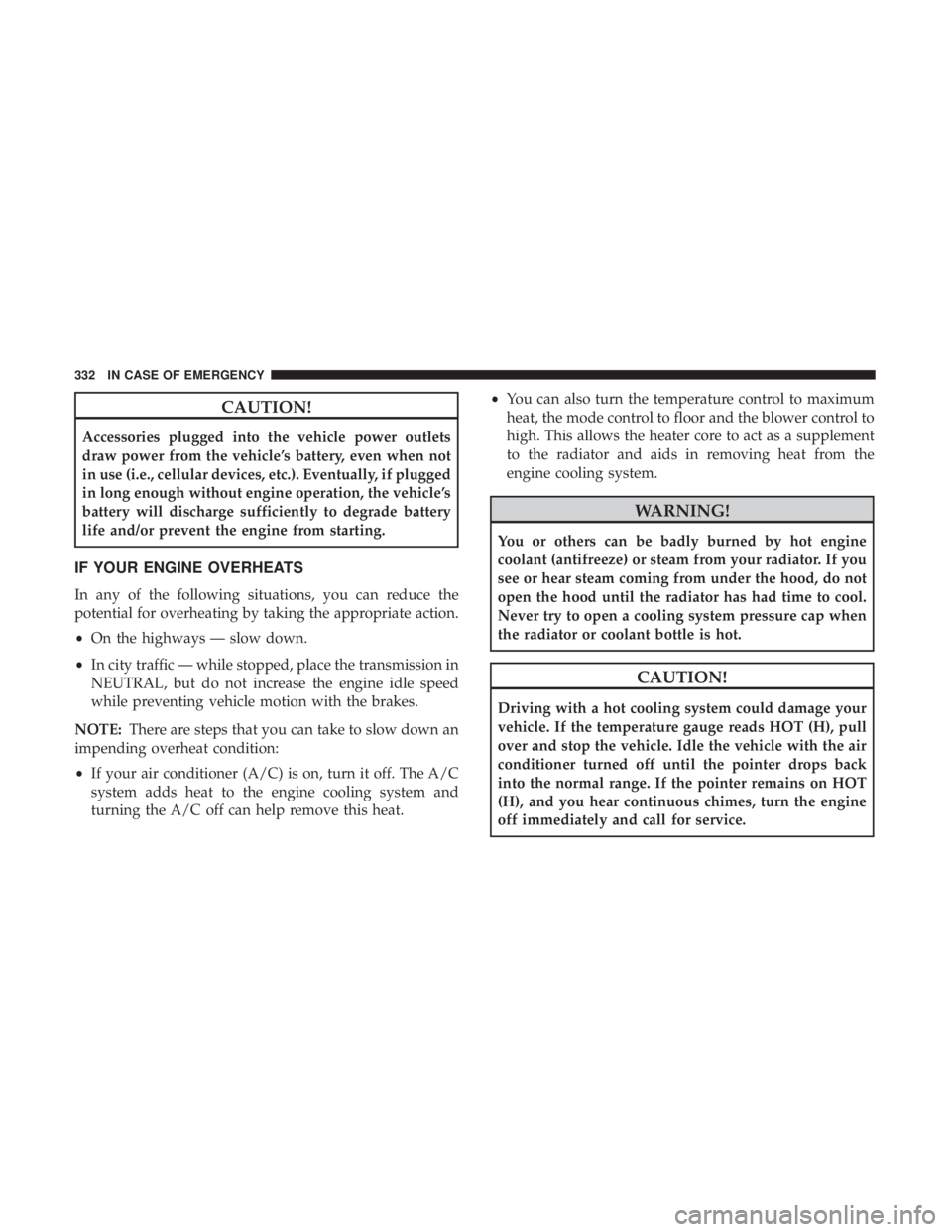
CAUTION!
Accessories plugged into the vehicle power outlets
draw power from the vehicle’s battery, even when not
in use (i.e., cellular devices, etc.). Eventually, if plugged
in long enough without engine operation, the vehicle’s
battery will discharge sufficiently to degrade battery
life and/or prevent the engine from starting.
IF YOUR ENGINE OVERHEATS
In any of the following situations, you can reduce the
potential for overheating by taking the appropriate action.
•On the highways — slow down.
• In city traffic — while stopped, place the transmission in
NEUTRAL, but do not increase the engine idle speed
while preventing vehicle motion with the brakes.
NOTE: There are steps that you can take to slow down an
impending overheat condition:
• If your air conditioner (A/C) is on, turn it off. The A/C
system adds heat to the engine cooling system and
turning the A/C off can help remove this heat. •
You can also turn the temperature control to maximum
heat, the mode control to floor and the blower control to
high. This allows the heater core to act as a supplement
to the radiator and aids in removing heat from the
engine cooling system.
WARNING!
You or others can be badly burned by hot engine
coolant (antifreeze) or steam from your radiator. If you
see or hear steam coming from under the hood, do not
open the hood until the radiator has had time to cool.
Never try to open a cooling system pressure cap when
the radiator or coolant bottle is hot.
CAUTION!
Driving with a hot cooling system could damage your
vehicle. If the temperature gauge reads HOT (H), pull
over and stop the vehicle. Idle the vehicle with the air
conditioner turned off until the pointer drops back
into the normal range. If the pointer remains on HOT
(H), and you hear continuous chimes, turn the engine
off immediately and call for service.
332 IN CASE OF EMERGENCY
Page 415 of 492
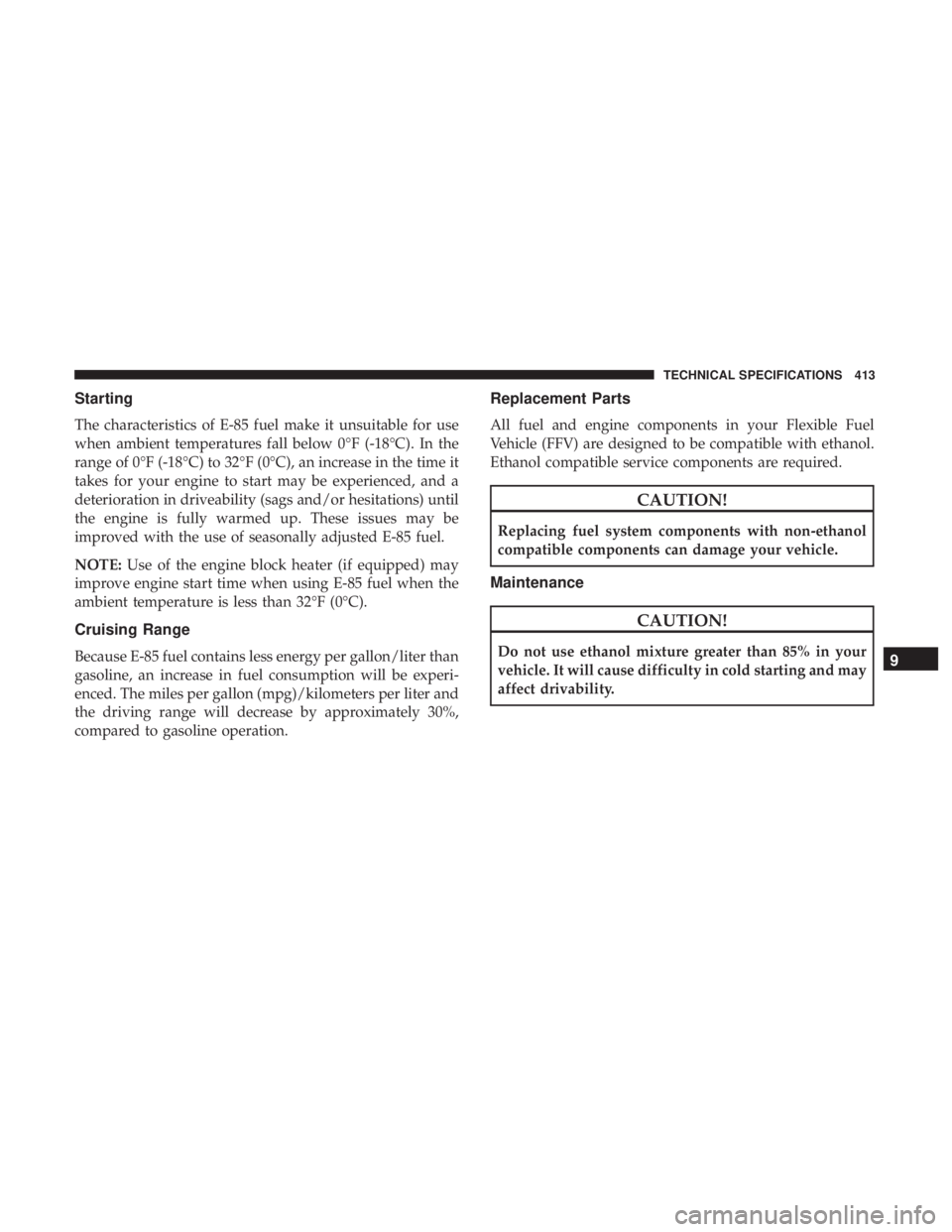
Starting
The characteristics of E-85 fuel make it unsuitable for use
when ambient temperatures fall below 0°F (-18°C). In the
range of 0°F (-18°C) to 32°F (0°C), an increase in the time it
takes for your engine to start may be experienced, and a
deterioration in driveability (sags and/or hesitations) until
the engine is fully warmed up. These issues may be
improved with the use of seasonally adjusted E-85 fuel.
NOTE:Use of the engine block heater (if equipped) may
improve engine start time when using E-85 fuel when the
ambient temperature is less than 32°F (0°C).
Cruising Range
Because E-85 fuel contains less energy per gallon/liter than
gasoline, an increase in fuel consumption will be experi-
enced. The miles per gallon (mpg)/kilometers per liter and
the driving range will decrease by approximately 30%,
compared to gasoline operation.
Replacement Parts
All fuel and engine components in your Flexible Fuel
Vehicle (FFV) are designed to be compatible with ethanol.
Ethanol compatible service components are required.
CAUTION!
Replacing fuel system components with non-ethanol
compatible components can damage your vehicle.
Maintenance
CAUTION!
Do not use ethanol mixture greater than 85% in your
vehicle. It will cause difficulty in cold starting and may
affect drivability.9
TECHNICAL SPECIFICATIONS 413
Page 416 of 492
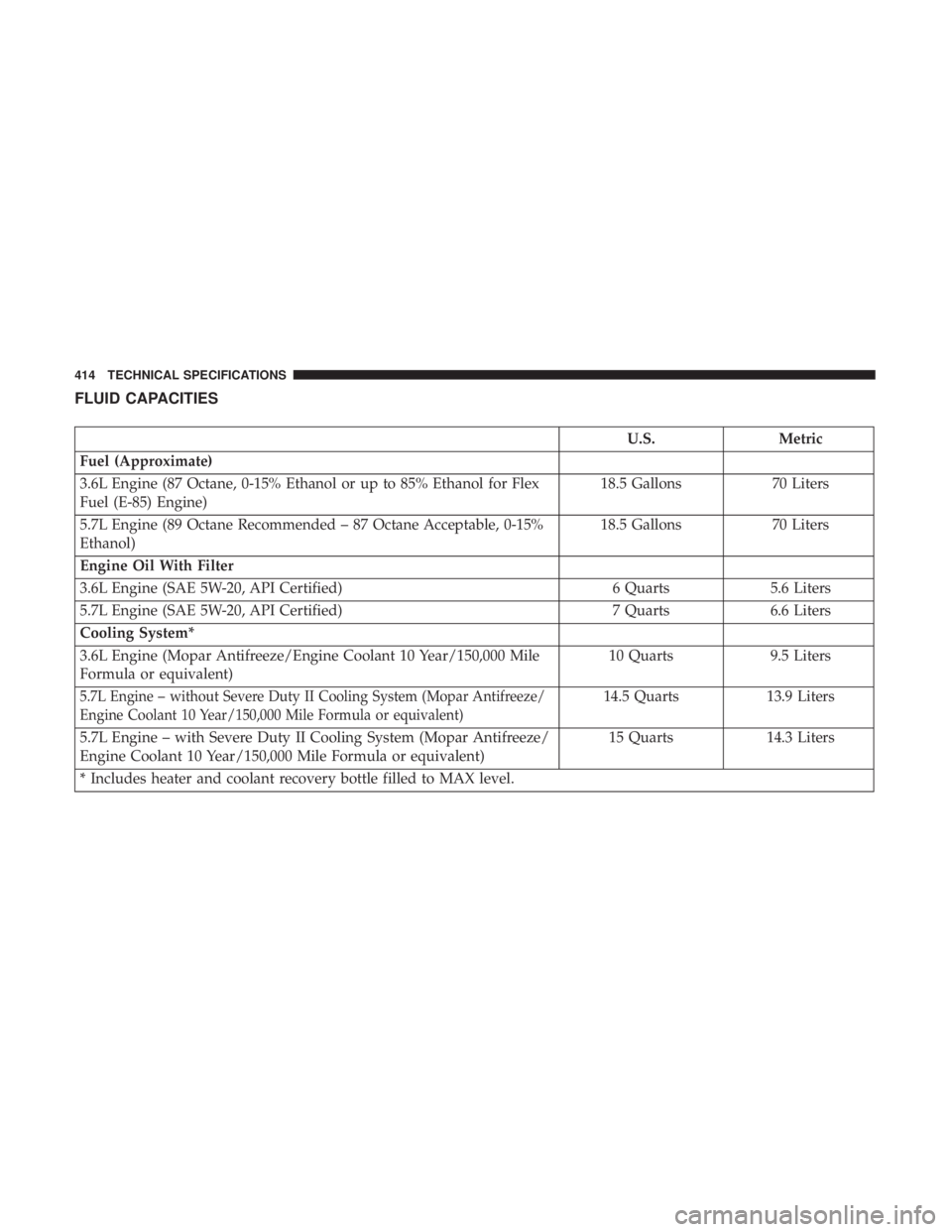
FLUID CAPACITIES
U.S.Metric
Fuel (Approximate)
3.6L Engine (87 Octane, 0-15% Ethanol or up to 85% Ethanol for Flex
Fuel (E-85) Engine) 18.5 Gallons
70 Liters
5.7L Engine (89 Octane Recommended – 87 Octane Acceptable, 0-15%
Ethanol) 18.5 Gallons
70 Liters
Engine Oil With Filter
3.6L Engine (SAE 5W-20, API Certified) 6 Quarts5.6 Liters
5.7L Engine (SAE 5W-20, API Certified) 7 Quarts6.6 Liters
Cooling System*
3.6L Engine (Mopar Antifreeze/Engine Coolant 10 Year/150,000 Mile
Formula or equivalent) 10 Quarts
9.5 Liters
5.7L Engine – without Severe Duty II Cooling System (Mopar Antifreeze/
Engine Coolant 10 Year/150,000 Mile Formula or equivalent)14.5 Quarts 13.9 Liters
5.7L Engine – with Severe Duty II Cooling System (Mopar Antifreeze/
Engine Coolant 10 Year/150,000 Mile Formula or equivalent) 15 Quarts
14.3 Liters
* Includes heater and coolant recovery bottle filled to MAX level.
414 TECHNICAL SPECIFICATIONS
Page 478 of 492
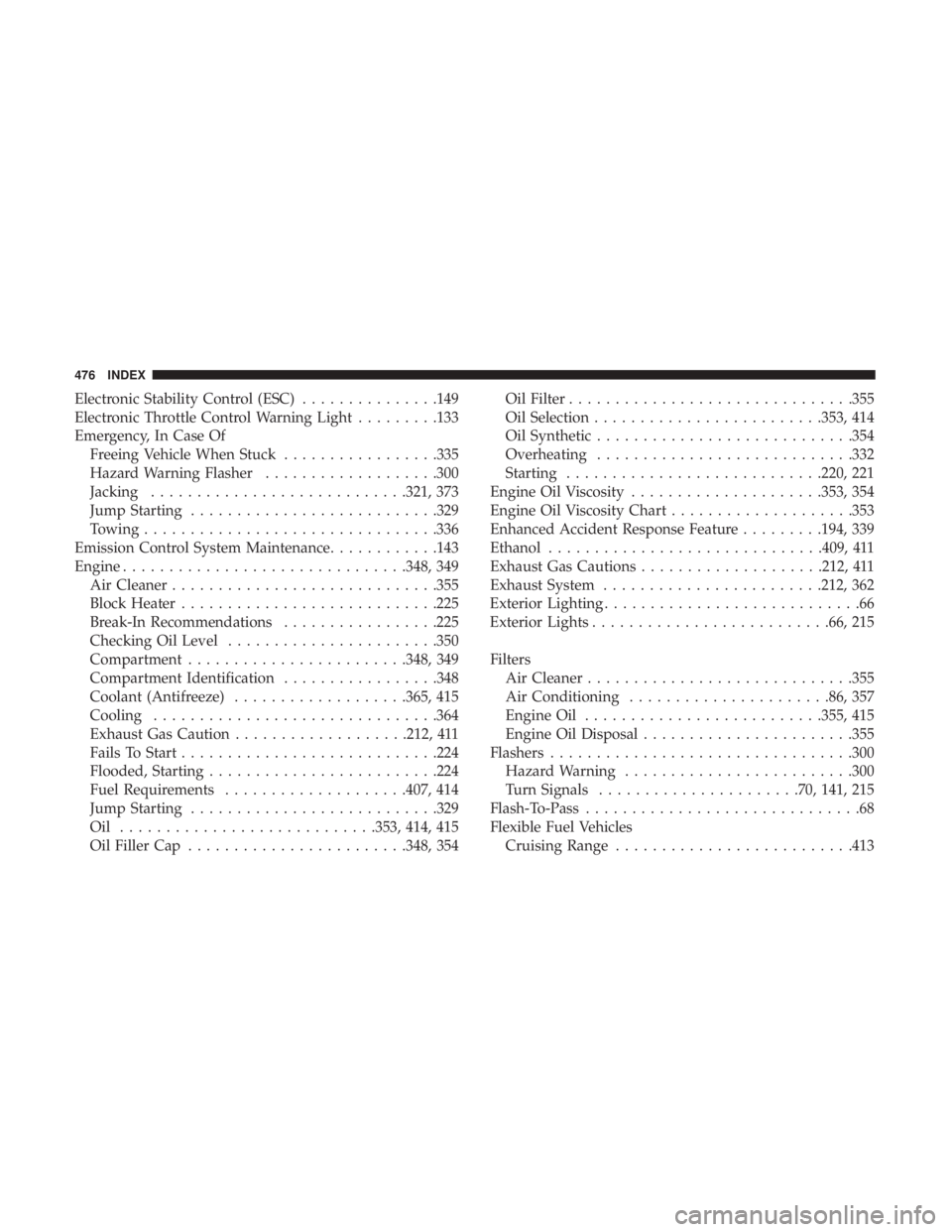
Electronic Stability Control (ESC)...............149
Electronic Throttle Control Warning Light .........133
Emergency, In Case Of Freeing Vehicle When Stuck .................335
Hazard Warning Flasher ...................300
Jacking ........................... .321, 373
Jump Starting .......................... .329
Towing ............................... .336
Emission Control System Maintenance ............143
Engine .............................. .348, 349
Air Cleaner ............................ .355
Block Heater ........................... .225
Break-In Recommendations .................225
Checking Oil Level ...................... .350
Compartment ....................... .348, 349
Compartment Identification .................348
Coolant (Antifreeze) ...................365, 415
Cooling .............................. .364
Exhaust Gas Caution ...................212, 411
Fails To Start ........................... .224
Flooded, Starting ........................ .224
Fuel Requirements ....................407, 414
Jump Starting .......................... .329
Oil ........................... .353, 414, 415
Oil Filler Cap ....................... .348, 354Oil Filter
.............................. .355
Oil Selection ........................ .353, 414
Oil Synthetic ........................... .354
Overheating ........................... .332
Starting ........................... .220, 221
Engine Oil Viscosity .....................353, 354
Engine Oil Viscosity Chart ....................353
Enhanced Accident Response Feature .........194, 339
Ethanol ............................. .409, 411
Exhaust Gas Cautions ................... .212, 411
Exhaust
System ....................... .212, 362
Exterior Lighting ............................66
Exterior Lights ......................... .66, 215
Filters Air Cleaner ............................ .355
Air Conditioning ..................... .86, 357
Engine Oil ......................... .355, 415
Engine Oil Disposal ...................... .355
Flashers ................................ .300
Hazard Warning ........................ .300
Turn Signals ..................... .70, 141, 215
Flash-To-Pass ..............................68
Flexible Fuel Vehicles Cruising Range ......................... .413
476 INDEX
Page 480 of 492
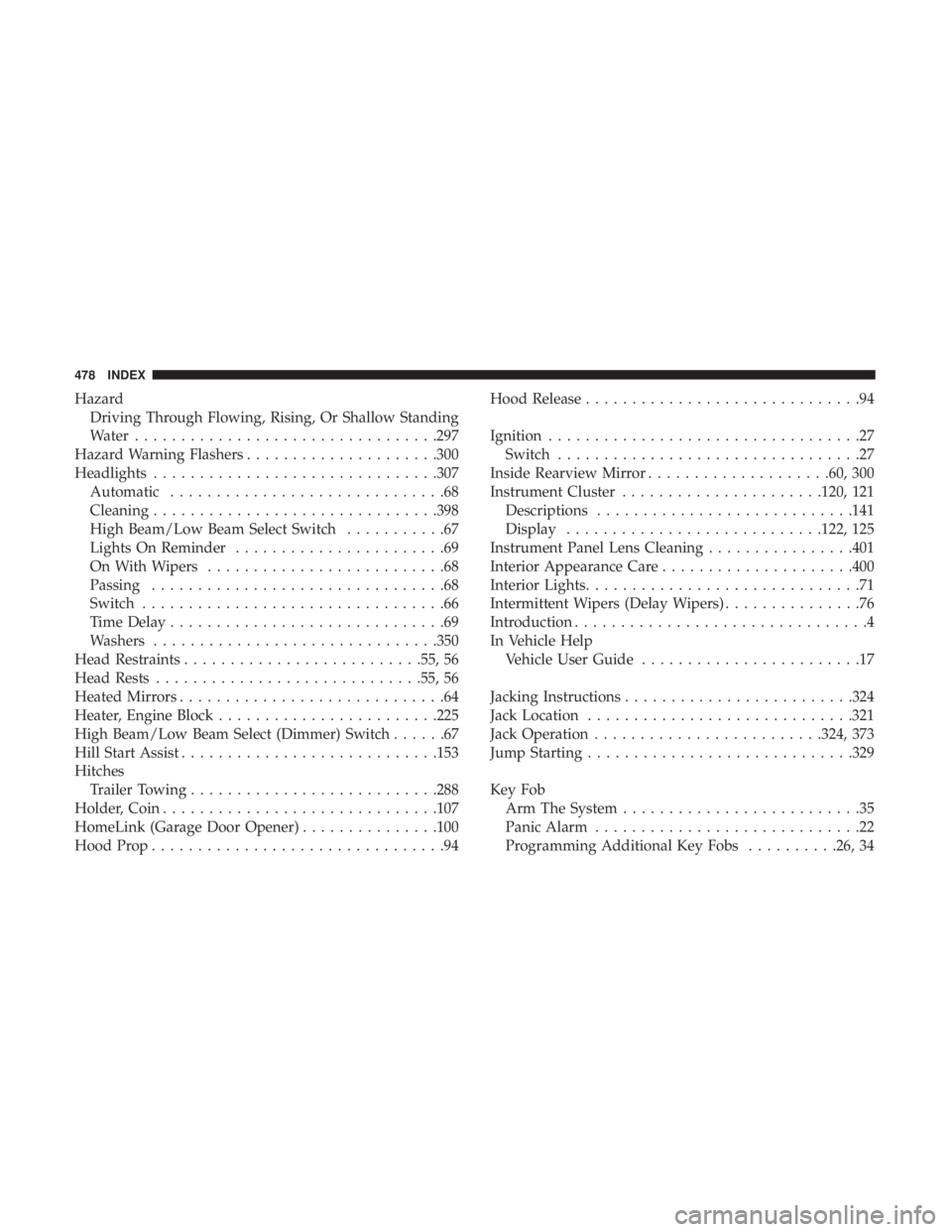
HazardDriving Through Flowing, Rising, Or Shallow Standing
Water ................................ .297
Hazard Warning Flashers .....................300
Headlights .............................. .307
Automatic ..............................68
Cleaning .............................. .398
High Beam/Low Beam Select Switch ...........67
Lights On Reminder .......................69
On With Wipers ..........................68
Passing ................................68
Switch .................................66
Time Delay ..............................69
Washers .............................. .350
Head Restraints ......................... .55, 56
Head Rests ............................ .55, 56
Heated Mirrors .............................64
Heater, Engine Block ....................... .225
High Beam/Low Beam Select (Dimmer) Switch ......67
Hill Start Assist ........................... .153
Hitches Trailer Towing .......................... .288
Holder, Coin ............................. .107
HomeLink (Garage Door Opener) ...............100
Hood Prop ................................94 Hood Release
..............................94
Ignition ..................................27
Switch .................................27
Inside Rearview Mirror ....................60, 300
Instrument Cluster ..................... .120, 121
Descriptions ........................... .141
Display ........................... .122, 125
Instrument Panel Lens Cleaning ................401
Interior Appearance Care .....................400
Interior Lights ..............................71
Intermittent Wipers (Delay Wipers) ...............76
Introduction ................................4
In Vehicle Help Vehicle User Guide ........................17
Jacking Instructions ........................ .324
Jack Location ............................ .321
Jack Operation ........................ .324, 373
Jump Starting ............................ .329
Key
Fob
Arm The System ..........................35
Panic Alarm .............................22
Programming Additional Key Fobs ..........26, 34
478 INDEX